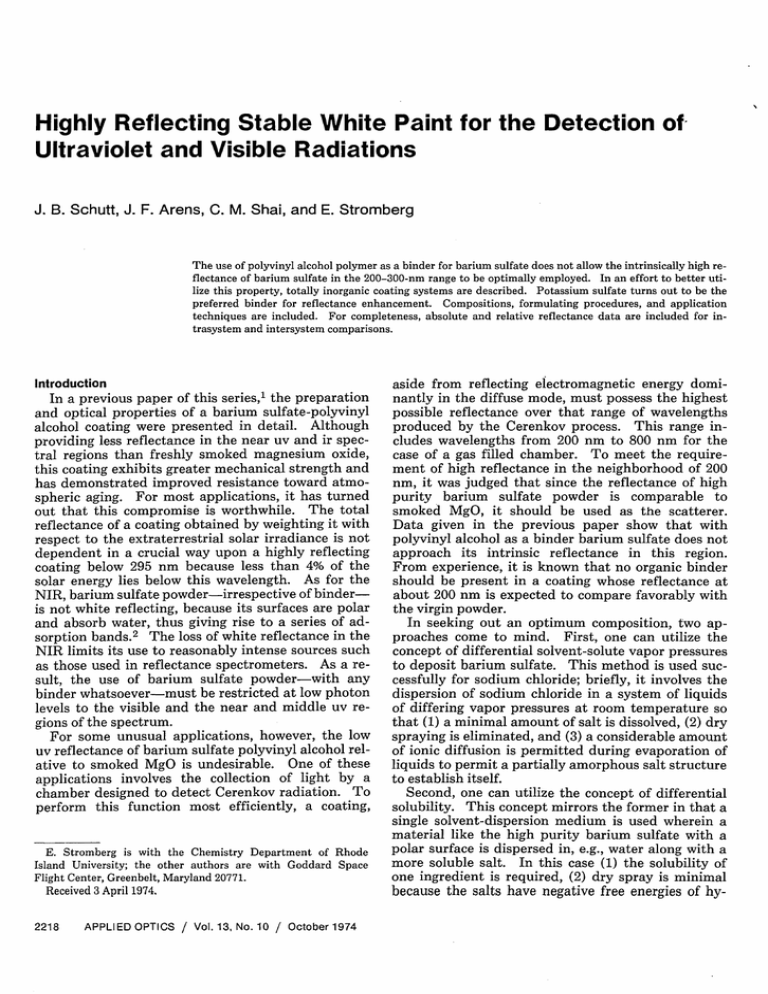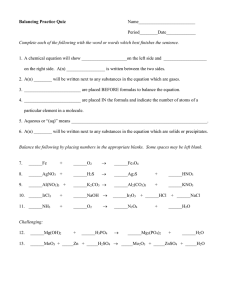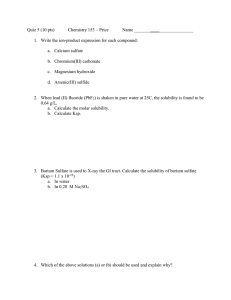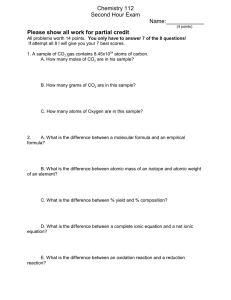Highly Reflecting Stable White Paint for the Detection
advertisement

Highly Reflecting Stable White Paint for the Detection of Ultraviolet and Visible Radiations J. B. Schutt, J. F. Arens, C. M. Shai, and E. Stromberg The use of polyvinyl alcohol polymer as a binder for barium sulfate does not allow the intrinsically high re- flectance of barium sulfate in the 200-300-nm range to be optimally employed. In an effort to better utilize this property, totally inorganic coating systems are described. Potassium sulfate turns out to be the preferred binder for reflectance enhancement. Compositions, formulating procedures, and application techniques are included. For completeness, absolute and relative reflectance data are included for intrasystem and intersystem comparisons. Introduction In a previous paper of this series,1 the preparation and optical properties of a barium sulfate-polyvinyl alcohol coating were presented in detail. Although providing less reflectance in the near uv and ir spectral regions than freshly smoked magnesium oxide, this coating exhibits greater mechanical strength and has demonstrated improved resistance toward atmospheric aging. For most applications, it has turned out that this compromise is worthwhile. The total reflectance of a coating obtained by weighting it with respect to the extraterrestrial solar irradiance is not dependent in a crucial way upon a highly reflecting coating below 295 nm because less than 4% of the solar energy lies below this wavelength. As for the NIR, barium sulfate powder-irrespective of binderis not white reflecting, because its surfaces are polar and absorb water, thus giving rise to a series of adsorption bands.2 The loss of white reflectance in the NIR limits its use to reasonably intense sources such as those used in reflectance spectrometers. As a result, the use of barium sulfate powder-with any binder whatsoever-must be restricted at low photon levels to the visible and the near and middle uv regions of the spectrum. For some unusual applications, however, the low uv reflectance of barium sulfate polyvinyl alcohol relative to smoked MgO is undesirable. One of these applications involves the collection of light by a chamber designed to detect Cerenkov radiation. To perform this function most efficiently, a coating, E. Stromberg is with the Chemistry Department of Rhode Island University; the other authors are with Goddard Space Flight Center, Greenbelt, Maryland 20771. Received 3 April 1974. 2218 APPLIED OPTICS / Vol. 13, No. 10 / October 1974 aside from reflecting electromagnetic energy dominantly in the diffuse mode, must possess the highest possible reflectance over that range of wavelengths produced by the Cerenkov process. This range includes wavelengths from 200 nm to 800 nm for the case of a gas filled chamber. To meet the requirement of high reflectance in the neighborhood of 200 nm, it was judged that since the reflectance of high purity barium sulfate powder is comparable to smoked MgO, it should be used as the scatterer. Data given in the previous paper show that with polyvinyl alcohol as a binder barium sulfate does not approach its intrinsic reflectance in this region. From experience, it is known that no organic binder should be present in a coating whose reflectance at about 200 nm is expected to compare favorably with the virgin powder. In seeking out an optimum composition, two approaches come to mind. First, one can utilize the concept of differential solvent-solute vapor pressures to deposit barium sulfate. This method is used successfully for sodium chloride; briefly, it involves the dispersion of sodium chloride in a system of liquids of differing vapor pressures at room temperature so that (1) a minimal amount of salt is dissolved, (2) dry spraying is eliminated, and (3) a considerable amount of ionic diffusion is permitted during evaporation of liquids to permit a partially amorphous salt structure to establish itself. Second, one can utilize the concept of differential solubility. This concept mirrors the former in that a single solvent-dispersion medium is used wherein a material like the high purity barium sulfate with a polar surface is dispersed in, e.g., water along with a more soluble salt. In this case (1) the solubility of one ingredient is required, (2) dry spray is minimal because the salts have negative free energies of hy- dration, and (3) the soluble salt crystallizes in the interstices between the barium sulfate particles providing a binding action that inhibits the self-crystallization of the binder and thus forms a heterogeneous matrix. Both types of coatings require primer systems because of their corrosive actions on commonly used metal substrates. The second system is preferably applied over a specially chosen primer, since additional mechanical strength is acquired by the reflective coating from the primer system. In the next section, compositions are given for the coatings systems as well as methods for formulating and applying them. Subsequently, the chemistry of the paints is presented followed by a section providing optical data for comparisons with other systems. Coating Development Prime Coat To obtain a suitable priming coating with maximum reflectance in the uv, a mixture was formed consisting of high purity aluminum oxide and a potassium silicate solution of composition [0.35(K2 0. 3.3SiO2)MOLE + 0.65H2OWT with sufficient additional water to allow the ingredients to be stirred together with a magnetic stirrer until alkaline hydration of the oxide was completed. At this stage, two sets of glass slides were flow coated with the mixture and dehydrated, one under ambient conditions for 24 h and the other at 1000C for 1 h. After each treatment, absolute reflectance measurements were made. It was judged from these data that the ratio sequence of (K20-3.3SiO2):A12 03 :H2 0:1:3.3:6.6 was most satisfactory. Reflective Coating Mixtures of (NH 4) 2SO4,-BaSO 4 , and water, as well as a saturated solution of K 2SO4 and BaSO 4 , were flow coated onto the optimum prime coat. Samples were cured according to the schedule used for the prime coat. Baking showed that as the total thickness of the coatings approached about 0.75-0.120 mm in thickness that samples became subject to bubbling and cracking. The optimum (NH4 ) 2SO4:BaSO4 ratio to be 1:6 by reflectance measurements; the system of BaSO4 with K2 SO4 as the bindwas determined er was found to give the greatest uv reflectance and was therefore judged to have the greatest potential for the detection of Cerenkov radiation in a high performance chamber. Paint Preparation Prime Coat To 35 parts of potassium silicate solution [0.35(K203.3SiO2)MoLE + 0.65H20]WT, 105 parts of A12 03 and 153 parts of water are added. The resulting mixture is then charged into a jar mill and milled for 1 h. The milled slurry is then applied by spraying until a dry thickness of about 0.2 mm is obtained (about 0.4 mm wet) and allowed to air cure at least 24 h before top coating. Air cure over a period of several hours is required to enable a good adhesive bond to develop between primer and substrate. Reflective Coatings Compositions optimized according to physical and optical characteristics are given in Table I. Systems with (NH 4 ) 2SO4 , (NH 4 )2 SO4 and K 2 SO4 , and K 2SO4 are given for the sake of completeness. K 2SO 4 alone gives the highest uv reflectance. These compositions may be prepared by adding the soluble sulfate(s) to the required amount of water and stirring until a solution is obtained. Finally the BaSO4 is added slowly and stirred until the composition is agglomerate free. Extreme care must be taken in mixing these ingredients together into the solution-slurry combination, because all contaminants will decrease the reflectance over at least a portion of the 200-300-nm band, with the effect being most noticeable in the neighborhood of 200 nm. Particularly harmful are trace amounts of metallic ions comprising the first, second, and third transition metal series in the Periodic Table as well as heavy metals such as lead. (For this reason, the barium sulfate used in this work was purchased from the Distillation Products Division of the Eastman Kodak Company under a product reference nomenclature of White Reflectance Standard. The potassium sulfate employed need only meet ACS Standards for purity.) Mixing must, as a result, be carried out in a Pyrex container employing a glass coated magnet for stirring. The container should be covered and stirring terminated as soon as the barium sulfate is dispersed, a process completed in 1 h or so for about 100 g of pigment. The coating is applied by spraying in one application if possible until a dry thickness of 0.2-0.75 mm is obtained depending upon application For efficient uv scattering a nominal thickness of 0.2 mm is more than sufficient; however, for a reflectance maximum through to 2400 nm, thicknesses to 0.75 mm may be required. Chemical Aspects The optimum coating composition and the one likely to be most often utilized will be BaSO4 dispersed in a 1% solution of K 2SO 4 as shown in Table I. However, because the composition has an acidic pH, care must be exercised in its use, especially since the prime coat is porous. A saturated solution of K2 SO4 has a pH of 5.8. Slurrying BaSO 4 at a level of 72 parts in 108 parts of water gives nominally a pH of 4.2. Combining the ingredients yields a pH whose value decreased with time from 4.7 to a minimum of 3.5 over a period of several days. If NaCl is substituted for K 2 SO 4 on a mole basis, a pH of 2.3 results at equilibrium. When coatings containing NaCl were applied to aluminum or iron protected by alkaline primer, it was noted that a percolation of aluminum metal or iron hydroxide to the surface of the reflective coating became visually detectable within 24 h. This indicated that the equilibrium pH of 2.3 for the coating containing NaCl was too low. October 1974 / Vol. 13, No. 10 / APPLIED OPTICS 2219 Briefly, what is occurring in the reflective coating slurry is the exchange of protons and monovalent cations between BaSO4 and solution. Schematically an equilibrium such as -BaSO4 -BaHSO4 .~~~~~~~~~~~ z. 90 u~O 80 solution contains K+ ions /. Fig. 1. LEGEND: E/ I 200 -BaKSO4 + H+, the equilibrium is shifted to the right side of the equation. The resulting pH for the coating composition is then dependent upon the ionization constant HSO4 / EL/Er + H is established, where -Ba represents a surface barium ion. It follows from the pH data that when the -BaHSO4 + K I240 KO, BINDER °~~NH,,SO,-KSO, BINDER NHS504 B NDER '~~~~ El POLYVINYL ALCOHOL BINDER 320 280 WAVELENGTH(nm) Ultraviolet reflectance of barium sulfate coatings employ- ing both organic and inorganic binders. =w H+ + SO4 as well, and in the case of sodium chloride HC1 HI + C1 For HS0 4-, Ka - 10-2, whereas for HCl, K 0 0(1). This simple scheme explains the pH observations for the particular concentrations of ingredients chosen for the measurements. The primer on the other hand is an alkaline com12. For the composite system, position of pH therefore, we need to address ourselves to an acidbase system comprising a rather complex system of potassium salts of barium sulfate, silicic acid, and to a lesser extent aluminum oxide. Since the primer is water sensitive, application of the reflective coating with its lower pH causes the silicic acid and aluminum oxide potassium salts to discharge by releasing ' potassium ions in exchange for protons. By the com- mon ion effect it follows that potassium sulfate will deionize and precipitate primarily in the interstices of the primer as well as onto BaSO 4 . Hence, the al- kalinity of the prime coat serves to prevent the growth of potassium sulfate crystals. The common ion effects derived from the dual presence of sulfate and potassium ions give intracoating and intercoating reactions, respectively, which serve to provide enhanced mechanical properties. Results Reflectance data for coatings discussed in previous sections are shown in graphic form in Figs. 1-3. Figure 1 shows reflectances for BaSO 4 coatings relative to BaSO4 powder employing both potassium and ammonium sulfate singly and in mixture as binders. Data for the polyvinyl chloride (PVA) paint have been included for reference. Figure 2 compares five highly reflecting coatings now in use: barium sulfate-polyvinyl alcohol (MS-125), the forerunner system developed by Eastman Kodak, smoked MgO, sodium chloride, and the potassium sulfate system described here over the alkaline primer. Figure 3, included for reference, compares polyvinyl alcohol powder, PVA paint (MS-125), high silica microballoons, and millipore filter paper type EA to BaSO4 . Comments In offering a highly reflecting paint employing barium sulfate as the scatterer and in utilizing an inorganic binder (e.g., K2SO4 ), rather than an organic one (e.g., polyvinyl alcohol), the reflectance has been improved down to about 200 nm, and improvement is also seen in the coating's aging characteristics as measured by reflectance changes in the uv. From Fig. 3 PVA is seen to have significant uv absorption compared to barium sulfate. Potassium sulfate (not shown), low in transition metal ion concentrations, will have significantly less absorption. PVA can also react slowly with barium sulfate by esterification; such is not the case with potassium sulfate. Under essentially ambient conditions degradation of reflectance did not appear to be a problem for the compositions listed in Table I. Each system, formulated using Eastman Kodak's white reflectance standard barium sulfate, was stored under dry nitrogen or desiccated air. No special illumination conditions were provided. The reflectances of all samples were mon- 100 z ' 90 q 80 MS 125 KODAK 0 EASTMAN SMOKEDMgO a NoCI -BaSO 4 , K2S04 BINDEROVER K2 0 . 3.3 S102 PRIMER v | X . i 500 WAVELENGTH (nm) 2220 360 APPLIED OPTICS / Vol. 13, No. 10 / October 1974 3000 Fig. 2. Comparisons of spectral reflectance data for MgO, MS-125, Eastman white reflectance standard, NaCl, and BaSO4 - K 2SO 4. a 0 0 1. 0 U z E Fig. 3. Curves showing relative uv reflectances of some candidate Cerenkov light reflecting materials. 280 WAVELENGTH(m) 360 Table I. Compositions of BaSO4 Coatings Using Sulfates with Monovalent Cations as Binders Compositions (NH4 ) 2S0 4 Coatings by binder Ammonium sulfate binder Potassium sulfate binder Mixed binder: ammonium sulfate, potassium sulfate K2 SO4 Parts by wt. S 12.0 14.4 1.01 1.01 - 6.25 7.4 0.7 0.5 - - 14.0 12.0 1.0 12.0 - 7.4 6.2 0.55 5.2 BaSO 4 Parts by wt. 0.009 1.014 1.014 0.009 1.01 1.01 1.01 - Trace 0.56 0.5 Trace 0.5 0.54 0.49 H 20 Parts by wt. % Parts by wt. S 72 72 72 72 72 72 72 72 72 72 72 37.5 37.0 39.7 35.5 40.0 39.7 35.5 37.0 37.3 39.5 30.6 108 108 108 130 108 108 130 108 108 108 150 56.2 55.5 59.6 64.0 60.0 59.6 64.0 55.5 56.0 59.4 63.7 BaSO 4 H20 itored monthly for 6 months by means of a Beckman DK-2A spectroreflectometer. Spectral variations in all cases were found not to exceed about 1%, the level normally considered the measurement accuracy of the instrument. On the other hand, the inorganic coating is more acidic than the mixed system, creating the problem of discoloration by corrosion. The alkaline primer solves the problem nicely provided the reflective coating is freshly prepared. As with all highly reflecting coatings, care must be continually exercised to keep them free from contaminants arising from all conceivable sources. As the uv reflectance is extended further into the near vacuum uv, contamination becomes more of a problem since most substances will degrade the performance of such a coating. The described paint is highly reflect- ing; ingredients admixed from other judicious choices in the periodic table will not improve reflectance further since the number of combinations is limited in which the electronegativity differences between cationic and anionic species are large. This work was supported by the High Energy Astrophysical Observatory Project (HEAO). References 1. J. B. Schutt and C. M. Shal, "Formulation Procedure and Spectral Data for a Highly Reflecting Coating from 200 nm to 2300 nm, "Internal Communication X-762-71-266 (1971), NASA Goddard Space Flight Center, Greenbelt, Maryland 20771. 2. L. Morren, G. Vandermaersch, and P. Antoine, Lighting Res. Technol. 4, 243 (1972). October 1974 / Vol. 13, No. 10 / APPLIED OPTICS 2221





